Sustainability-Oriented Optimization and Decision Making of Community Buildings under Seismic Hazard
Abstract
:1. Introduction
2. Proposed Multi-Objective Decision-Making Framework
3. Performance-Based Assessment of Buildings
3.1. Damage Assessment
3.2. Consequence Assessment
3.3. Performance Objectives Assessment
4. Multi-Objective Evolutionary Optimization
4.1. Evaluating Performance Objectives
4.2. Ranking Individuals
| Algorithm 1: Fast Non-Dominated Sorting (P) |
| Stage 1: (Non-dominated solutions) Stage 2: (dominated solutions) 01. For each p ϵ P i = 1 02. Sp = [ ], np = 0 While Fi ≠ [ ] 03. For each q ϵ P Q = [ ] 04. If (p Հ q) For p ϵ Fi 05. Sp = Sp U q For q ϵ Sp 06. Else If (q Հ p) nq = nq − 1 07. np = np + 1 If nq = 0 08. End If qrank = i + 1 09. End For Q = Q U [q] 10. If np = 0 End If 11. prank = 1 End For 12. F1 = F1 U [p] End For 13. End If i = i + 1 14. End For Fi = Q 15. End While |
| Algorithm 2: Crowding distance (F) |
| 01. r = |F| 02. for each i ϵ F, set di = 0 03. For each objective m 04. F = sort (F, m) 05. d1 = dr = ∞ 06. For I = 2 to (r − 1) 07. di = di + [(|fm(i + 1)− fm(i − 1)|)/(fmmax − fmmin)] 08. End For 09. End For |
4.3. Generating New Population
5. Multi-Objective Decision Making
5.1. Analytic Hierarchy Process (AHP)
5.2. Technique for Order of Preference by Similarity to Ideal Solution (TOPSIS)
6. Illustrative Example
6.1. Performance-Based Assessment
6.2. Multi-Objective Evolutionary Optimization
6.3. Multi-Objective Decision Making
7. Conclusions
- The proposed approach considered sustainability-oriented performance-based assessment techniques with genetic optimization and decision-making methods to provide meaningful information to decision makers. For instance, in the considered example, retrofit costs ranging from USD 141 to 164 million provide the best performance for the given weighting factors provided by the AHP.
- The damage to the buildings increased with the increasing intensity of hazard scenarios. For instance, for the frequent level earthquake scenario, 29.2% of buildings suffered no damage and 10.1% of buildings suffered complete damage, while for the maximum considered earthquake, the buildings with no damage decreased to 1%, while the buildings with complete damage increased to 67.9%.
- Similarly, with the increasing intensity of the hazard scenarios, the socioeconomic and environmental consequences increased. For instance, the casualties increased from 1832 to 6415, 9381, and 12,457 for the four hazard scenarios of increasing intensity, the repair costs increased from USD 133.58 million to 560.81 million, the carbon emissions increased from 2.95 million tons to 13.99 million tons, and the total downtime increased from 3.88 million days to 8.92 million days.
- Pre-hazard retrofit alternatives were utilized to increase the performance indicators against the retrofit costs. For instance, applying a retrofit worth USD 5 million results in a 25.7% reduction in risk for the frequent-level earthquake scenario, and a 16.67% reduction in risk for the maximum considered earthquake scenario. In terms of USD, applying a retrofit of USD 5 million can save USD 36.1 million in case of a frequent-level earthquake, and 91.9 million USD in case of the maximum considered earthquake scenario.
Author Contributions
Funding
Institutional Review Board Statement
Informed Consent Statement
Data Availability Statement
Conflicts of Interest
Appendix A
| ID | Building Type | Code Level | Damage State | Fragility Function (g) |
|---|---|---|---|---|
| URML-P | Low-Rise Unreinforced Masonry Bearing Walls | P-C | S M E C | 0.13 0.17 0.26 0.37 |
| URML-L | Low-Rise Unreinforced Masonry Bearing Walls | L-C | S M E C | 0.14 0.20 0.32 0.46 |
| URMM-L | Mid-Rise Unreinforced Masonry Bearing Walls | L-C | S M E C | 0.10 0.16 0.27 0.46 |
| C3L-L | Low-Rise Concrete Frame with Unreinforced Masonry Infill Walls | L-C | S M E C | 0.12 0.17 0.26 0.44 |
| C3M-L | Mid-Rise Concrete Frame with Unreinforced Masonry Infill Walls | L-C | S M E C | 0.11 0.17 0.32 0.51 |
| C1M-L | Mid-Rise Concrete Moment Frame | L-C | S M E C | 0.12 0.17 0.32 0.54 |
| C1M-M | Mid-Rise Concrete Moment Frame | M-C | S M E C | 0.13 0.21 0.49 0.89 |
| ID | Construction Materials | Tons kg/ Thousand Square Feet |
|---|---|---|
| URMM-L, URML-L, URML-P, URMM-L | Brick | 35 |
| Wood | 10.5 | |
| Concrete | 41 | |
| Steel | 4 | |
| C1M-M, C1M-L, C3M-L, C3L-L | Brick | 20 |
| Wood | 5.3 | |
| Concrete | 90 | |
| Steel | 4 |
| Construction Materials | Cost in USD per kg Tons | Tons kgCO2 Emissions per kg Tons |
|---|---|---|
| Brick | 28 | 0.2–0.6 |
| Wood | 140 | 0.75–1.35 |
| Concrete | 20 | 0.05–5.15 |
| Steel | 650 | 1.72–2.82 |
| ID | Damage State | Percentage of Material Damaged Given Damage State | |||
|---|---|---|---|---|---|
| Brick | Wood | Concrete | Steel | ||
| URMM-L, URML-L, URML-P | S | 3.5 | 3.5 | 0 | 0 |
| M | 18.5 | 18.5 | 6 | 6 | |
| E | 50 | 50 | 27 | 27 | |
| C | 100 | 100 | 100 | 100 | |
| C3L-L, C3M-L | S | 3 | 3 | 0.05 | 0.05 |
| M | 16 | 16 | 7 | 7 | |
| E | 47.5 | 47.5 | 31 | 31 | |
| C | 100 | 100 | 100 | 100 | |
| C1M-L, C1M-M | S | 0.5 | 0.5 | 0.05 | 0.05 |
| M | 3.5 | 3.5 | 6.5 | 6.5 | |
| E | 17.5 | 17.5 | 30.5 | 30.5 | |
| C | 100 | 100 | 100 | 100 | |
References
- Doughty, M.R.; Hammond, G.P. Sustainability and the built environment at and beyond the city scale. Build. Environ. 2004, 39, 1223–1233. [Google Scholar] [CrossRef]
- Kylili, A.; Fokaides, P.A.; Jimenez, P.A.L. Key Performance Indicators (KPIs) approach in buildings renovation for the sustainability of the built environment: A review. Renew. Sustain. Energy Rev. 2016, 56, 906–915. [Google Scholar] [CrossRef]
- Invidiata, A.; Lavagna, M.; Ghisi, E. Selecting design strategies using multi-criteria decision making to improve the sustainability of buildings. Build. Environ. 2018, 139, 58–68. [Google Scholar] [CrossRef]
- Ingrao, C.; Messineo, A.; Beltramo, R.; Yigitcanlar, T.; Ioppolo, G. How can life cycle thinking support sustainability of buildings? Investigating life cycle assessment applications for energy efficiency and environmental performance. J. Clean. Prod. 2018, 201, 556–569. [Google Scholar] [CrossRef]
- Poveda, C.A.; Lipsett, M.G. A review of sustainability assessment and sustainability/environmental rating systems and credit weighting tools. J. Sustain. Dev. 2011, 4, 36. [Google Scholar] [CrossRef]
- Nelms, C.; Russell, A.D.; Lence, B.J. Assessing the performance of sustainable technologies for building projects. Can. J. Civ. Eng. 2005, 32, 114–128. [Google Scholar] [CrossRef]
- Frangopol, D.M.; Soliman, M. Life-cycle of structural systems: Recent achievements and future directions. In Structures and Infrastructure Systems; Routledge: Abingdon-on-Thames, UK, 2019; pp. 46–65. [Google Scholar]
- Hossaini, N.; Reza, B.; Akhtar, S.; Sadiq, R.; Hewage, K. AHP based life cycle sustainability assessment (LCSA) framework: A case study of six storey wood frame and concrete frame buildings in Vancouver. J. Environ. Plan. Manag. 2015, 58, 1217–1241. [Google Scholar] [CrossRef]
- Lounis, Z.; McAllister, T.P. Risk-based decision making for sustainable and resilient infrastructure systems. J. Struct. Eng. 2016, 142, F4016005. [Google Scholar] [CrossRef] [Green Version]
- Kamali, M.; Hewage, K.; Milani, A.S. Life cycle sustainability performance assessment framework for residential modular buildings: Aggregated sustainability indices. Build. Environ. 2018, 138, 21–41. [Google Scholar] [CrossRef]
- Passoni, C.; Marini, A.; Belleri, A.; Menna, C. Redefining the concept of sustainable renovation of buildings: State of the art and an LCT-based design framework. Sustain. Cities Soc. 2021, 64, 102519. [Google Scholar] [CrossRef]
- Hay, J.; Mimura, N. The changing nature of extreme weather and climate events: Risks to sustainable development. Geomat. Nat. Hazards Risk 2010, 1, 3–18. [Google Scholar] [CrossRef]
- Li, C.; Lu, T.; Fu, B.; Wang, S.; Holden, J. Sustainable city development challenged by extreme weather in a warming world. Geogr. Sustain. 2022, 3, 114–118. [Google Scholar] [CrossRef]
- Anwar, G.A.; Dong, Y.; Li, Y. Performance-based decision-making of buildings under seismic hazard considering long-term loss, sustainability, and resilience. Struct. Infrastruct. Eng. 2020, 17, 454–470. [Google Scholar] [CrossRef]
- Zhou, Z.; Anwar, G.A.; Dong, Y. Performance-Based Bi-Objective Retrofit Optimization of Building Portfolios Considering Uncertainties and Environmental Impacts. Buildings 2022, 12, 85. [Google Scholar] [CrossRef]
- Zhong, J.; Mao, Y.; Yuan, X. Lifetime seismic risk assessment of bridges with construction and aging considerations. Structures 2023, 47, 2259–2272. [Google Scholar] [CrossRef]
- Barbat, A.H.; Carreño, M.L.; Pujades, L.G.; Lantada, N.; Cardona, O.D.; Marulanda, M.C. Seismic vulnerability and risk evaluation methods for urban areas. A review with application to a pilot area. Struct. Infrastruct. Eng. 2010, 6, 17–38. [Google Scholar] [CrossRef]
- Newman, J.P.; Maier, H.R.; Riddell, G.A.; Zecchin, A.C.; Daniell, J.E.; Schaefer, A.M.; van Delden, H.; Khazai, B.; O’Flaherty, M.J.; Newland, C.P. Review of literature on decision support systems for natural hazard risk reduction: Current status and future research directions. Environ. Model. Softw. 2017, 96, 378–409. [Google Scholar] [CrossRef]
- Kircher, C.A.; Whitman, R.V.; Holmes, W.T. HAZUS earthquake loss estimation methods. Nat. Hazards Rev. 2006, 7, 45–59. [Google Scholar] [CrossRef]
- Whitman, R.V.; Anagnos, T.; Kircher, C.A.; Lagorio, H.J.; Lawson, R.S.; Schneider, P. Development of a national earthquake loss estimation methodology. Earthq. Spectra 1997, 13, 643–661. [Google Scholar] [CrossRef]
- Silva, V.; Crowley, H.; Pagani, M.; Monelli, D.; Pinho, R. Development of the OpenQuake engine, the Global Earthquake Model’s open-source software for seismic risk assessment. Nat. Hazards 2014, 72, 1409–1427. [Google Scholar] [CrossRef]
- Khan, M.A.; Khan, A.A.; Anwar, G.A.; Usmani, A. Framework for fire risk assessment of bridges. Structures 2021, 33, 523–532. [Google Scholar] [CrossRef]
- Hughes, W.; Zhang, W.; Ding, Z. Multiobjective Optimization for Hurricane Retrofit to Improve Coastal Community Structural and Socioeconomic Resilience. Nat. Hazards Rev. 2022, 23, 04022033. [Google Scholar] [CrossRef]
- Joyner, M.D.; Kurth, M.H.; Pumo, I.; Linkov, I. Recovery-based design of buildings for seismic resilience. Int. J. Disaster Risk Reduct. 2021, 65, 102556. [Google Scholar] [CrossRef]
- Bruneau, M.; Chang, S.E.; Eguchi, R.T.; Lee, G.C.; O’Rourke, T.D.; Reinhorn, A.M.; Shinozuka, M.; Tierney, K.; Wallace, W.A.; Von Winterfeldt, D. A framework to quantitatively assess and enhance the seismic resilience of communities. Earthq. Spectra 2003, 19, 733–752. [Google Scholar] [CrossRef] [Green Version]
- Cimellaro, G.P.; Reinhorn, A.M.; Bruneau, M. Framework for analytical quantification of disaster resilience. Eng. Struct. 2010, 32, 3639–3649. [Google Scholar] [CrossRef]
- Cimellaro, G.P.; Reinhorn, A.M.; Bruneau, M. Seismic resilience of a hospital system. Struct. Infrastruct. Eng. 2010, 6, 127–144. [Google Scholar] [CrossRef]
- Burton, H.V.; Deierlein, G.; Lallemant, D.; Lin, T. Framework for incorporating probabilistic building performance in the assessment of community seismic resilience. J. Struct. Eng. 2015, 142, C4015007. [Google Scholar] [CrossRef] [Green Version]
- Miles, S.B.; Burton, H.V.; Kang, H. Community of Practice for Modeling Disaster Recovery. Nat. Hazards Rev. 2018, 20, 04018023. [Google Scholar] [CrossRef]
- Anwar, G.A.; Dong, Y.; Ouyang, M. Systems thinking approach to community buildings resilience considering utility networks, interactions, and access to essential facilities. Bull. Earthq. Eng. 2022, 21, 633–661. [Google Scholar] [CrossRef]
- Feng, K.; Wang, N.; Li, Q.; Lin, P. Measuring and enhancing resilience of building portfolios considering the functional interdependence among community sectors. Struct. Saf. 2017, 66, 118–126. [Google Scholar] [CrossRef]
- Lin, P.; Wang, N. Stochastic post-disaster functionality recovery of community building portfolios I: Modeling. Struct. Saf. 2017, 69, 96–105. [Google Scholar] [CrossRef]
- Masoomi, H.; Burton, H.; Tomar, A.; Mosleh, A. Simulation-Based Assessment of Postearthquake Functionality of Buildings with Disruptions to Cross-Dependent Utility Networks. J. Struct. Eng. 2020, 146, 04020070. [Google Scholar] [CrossRef]
- Alisjahbana, I.; Kiremidjian, A. Modeling housing recovery after the 2018 Lombok earthquakes using a stochastic queuing model. Earthq. Spectra 2021, 37, 587–611. [Google Scholar] [CrossRef]
- Gonzalez, C.; Niño, M.; Jaimes, M.A. Event-based assessment of seismic resilience in Mexican school buildings. Bull. Earthq. Eng. 2020, 18, 6313–6336. [Google Scholar] [CrossRef]
- Logan, T.M.; Guikema, S.D. Reframing Resilience: Equitable Access to Essential Services. Risk Anal. 2020, 40, 1538–1553. [Google Scholar] [CrossRef] [PubMed]
- Nozhati, S.; Rosenheim, N.; Ellingwood, B.R.; Mahmoud, H.; Perez, M.J.S.; Engineering, I. Probabilistic framework for evaluating food security of households in the aftermath of a disaster. Struct. Infrastruct. Eng. 2019, 15, 1060–1074. [Google Scholar] [CrossRef]
- Hassan, E.M.; Mahmoud, H. An integrated socio-technical approach for post-earthquake recovery of interdependent healthcare system. Reliab. Eng. Syst. Saf. 2020, 201, 106953. [Google Scholar] [CrossRef]
- Caruso, M.; Pinho, R.; Bianchi, F.; Cavalieri, F.; Lemmo, M.T. Multi-criteria decision-making approach for optimal seismic/energy retrofitting of existing buildings. Earthq. Spectra 2023, 39, 191–217. [Google Scholar] [CrossRef]
- Anwar, G.A.; Dong, Y. Surrogate-based decision-making of community building portfolios under uncertain consequences and risk attitudes. Eng. Struct. 2022, 268, 114749. [Google Scholar] [CrossRef]
- Zheng, Y.; Dong, Y.; Che, B.; Anwar, G.A. Seismic damage mitigation of bridges with self-adaptive SMA-cable-based bearings. Smart Struct. Syst. Int. J. 2019, 24, 127–139. [Google Scholar]
- Masoomi, H.; van de Lindt, J.W. Community-Resilience-Based Design of the Built Environment. ASCE-ASME J. Risk Uncertain. Eng. Syst. Part A Civ. Eng. 2018, 5, 04018044. [Google Scholar] [CrossRef]
- Kameshwar, S.; Cox, D.T.; Barbosa, A.R.; Farokhnia, K.; Park, H.; Alam, M.S.; van de Lindt, J.W. Probabilistic decision-support framework for community resilience: Incorporating multi-hazards, infrastructure interdependencies, and resilience goals in a Bayesian network. Reliab. Eng. Syst. Saf. 2019, 191, 106568. [Google Scholar] [CrossRef]
- Yu, X.; Gen, M. Introduction to Evolutionary Algorithms; Springer Science & Business Media: Berlin/Heidelberg, Germany, 2010. [Google Scholar]
- Anwar, G.A.; Dong, Y.; Zhai, C. Performance-based probabilistic framework for seismic risk, resilience, and sustainability assessment of reinforced concrete structures. Adv. Struct. Eng. 2020, 23, 1454–1472. [Google Scholar] [CrossRef]
- Clemett, N.; Carofilis Gallo, W.W.; Gabbianelli, G.; O’Reilly, G.J.; Monteiro, R. Optimal Combined Seismic and Energy Efficiency Retrofitting for Existing Buildings in Italy. J. Struct. Eng. 2023, 149, 04022207. [Google Scholar] [CrossRef]
- Mauro, G.M.; Menna, C.; Vitiello, U.; Asprone, D.; Ascione, F.; Bianco, N.; Prota, A.; Vanoli, G.P. A multi-step approach to assess the lifecycle economic impact of seismic risk on optimal energy retrofit. Sustainability 2017, 9, 989. [Google Scholar] [CrossRef] [Green Version]
- Krawinkler, H.; Zareian, F.; Medina, R.A.; Ibarra, L.F. Decision support for conceptual performance-based design. Earthq. Eng. Struct. Dyn. 2006, 35, 115–133. [Google Scholar] [CrossRef]
- Dong, Y.; Frangopol, D.M. Performance-based seismic assessment of conventional and base-isolated steel buildings including environmental impact and resilience. Earthq. Eng. Struct. Dyn. 2016, 45, 739–756. [Google Scholar] [CrossRef]
- Qian, J.; Dong, Y. Uncertainty and multi-criteria global sensitivity analysis of structural systems using acceleration algorithm and sparse polynomial chaos expansion. Mech. Syst. Signal Process. 2022, 163, 108120. [Google Scholar] [CrossRef]
- Cornell, C.A. Engineering seismic risk analysis. Bull. Seismol. Soc. Am. 1968, 58, 1583–1606. [Google Scholar] [CrossRef]
- Stewart, J.P.; Douglas, J.; Javanbarg, M.; Bozorgnia, Y.; Abrahamson, N.A.; Boore, D.M.; Campbell, K.W.; Delavaud, E.; Erdik, M.; Stafford, P.J. Selection of ground motion prediction equations for the global earthquake model. Earthq. Spectra 2015, 31, 19–45. [Google Scholar] [CrossRef] [Green Version]
- Qian, J.; Dong, Y. Multi-criteria decision making for seismic intensity measure selection considering uncertainty. Earthq. Eng. Struct. Dyn. 2020, 49, 1095–1114. [Google Scholar] [CrossRef]
- Cardone, D.; Perrone, G. Damage and loss assessment of pre-70 RC frame buildings with FEMA P-58. J. Earthq. Eng. 2017, 21, 23–61. [Google Scholar] [CrossRef]
- Kim, J.-H.; Han, J.-H.; Kim, Y.-H.; Choi, S.-H.; Kim, E.-S. Preference-based solution selection algorithm for evolutionary multiobjective optimization. IEEE Trans. Evol. Comput. 2011, 16, 20–34. [Google Scholar] [CrossRef]
- Wang, F.; Li, Y.; Zhang, H.; Hu, T.; Shen, X.-L. An adaptive weight vector guided evolutionary algorithm for preference-based multi-objective optimization. Swarm Evol. Comput. 2019, 49, 220–233. [Google Scholar] [CrossRef]
- Aziz, S.; Jiang, H.; Peng, J.-C.; Ruan, J.-Q.; Wang, H.-Z. Optimization of base operation points of MTDC grid for improving transition smooth. In Proceedings of the 2017 IEEE Conference on Energy Internet and Energy System Integration (EI2), Beijing, China, 26–28 November 2017; pp. 1–6. [Google Scholar]
- Deb, K.; Pratap, A.; Agarwal, S.; Meyarivan, T. A fast and elitist multiobjective genetic algorithm: NSGA-II. IEEE Trans. Evol. Comput. 2002, 6, 182–197. [Google Scholar] [CrossRef] [Green Version]
- Aziz, S.; Peng, J.; Wang, H.; Jiang, H. Admm-based distributed optimization of hybrid mtdc-ac grid for determining smooth operation point. IEEE Access 2019, 7, 74238–74247. [Google Scholar] [CrossRef]
- Deb, K. Multi-objective optimisation using evolutionary algorithms: An introduction. In Multi-Objective Evolutionary Optimisation for Product Design and Manufacturing; Springer: Berlin/Heidelberg, Germany, 2011; pp. 3–34. [Google Scholar]
- Saaty, T.L. A scaling method for priorities in hierarchical structures. J. Math. Psychol. 1977, 15, 234–281. [Google Scholar] [CrossRef]
- Tang, Y.; Lam, N.; Tsang, H.-H.; Lumantarna, E. An adaptive ground motion prediction equation for use in low-to-moderate seismicity regions. J. Earthq. Eng. 2022, 26, 2567–2598. [Google Scholar] [CrossRef]
- Katsanos, E.I.; Sextos, A.G.; Manolis, G.D. Selection of earthquake ground motion records: A state-of-the-art review from a structural engineering perspective. Soil Dyn. Earthq. Eng. Struct. Dyn. 2010, 30, 157–169. [Google Scholar] [CrossRef]
- Waseem, M.; Khan, S.; Khan, M.A. Probabilistic Seismic Hazard Assessment of Pakistan Territory Using an Areal Source Model. Pure Appl. Geophys. 2020, 177, 3577–3597. [Google Scholar] [CrossRef]
- HAZUS. Multi-Hazard Loss Estimation Methodology, Earthquake Model; Department of Homeland Security, FEMA: Washington, DC, USA, 2003.
- Chau, C.; Hui, W.; Ng, W.; Powell, G. Assessment of CO2 emissions reduction in high-rise concrete office buildings using different material use options. Resour. Conserv. Recycl. 2012, 61, 22–34. [Google Scholar] [CrossRef]
- Gencturk, B.; Hossain, K.; Lahourpour, S. Life cycle sustainability assessment of RC buildings in seismic regions. Eng. Struct. 2016, 110, 347–362. [Google Scholar] [CrossRef]
- Ma, C.-K.; Apandi, N.M.; Sofrie, C.S.Y.; Ng, J.H.; Lo, W.H.; Awang, A.Z.; Omar, W. Repair and rehabilitation of concrete structures using confinement: A review. Constr. Build. Mater. 2017, 133, 502–515. [Google Scholar] [CrossRef]
- Mwafy, A.; Elkholy, S. Performance assessment and prioritization of mitigation approaches for pre-seismic code structures. Adv. Struct. Eng. 2017, 20, 917–939. [Google Scholar] [CrossRef]
- Caterino, N.; Iervolino, I.; Manfredi, G.; Cosenza, E. Comparative analysis of multi-criteria decision-making methods for seismic structural retrofitting. Comput.-Aided Civ. Infrastruct. Eng. 2009, 24, 432–445. [Google Scholar] [CrossRef]
- Caterino, N.; Iervolino, I.; Manfredi, G.; Cosenza, E. Multi-criteria decision making for seismic retrofitting of RC structures. J. Earthq. Eng. 2008, 12, 555–583. [Google Scholar] [CrossRef]
- Anwar, G.A.; Dong, Y. Seismic resilience of retrofitted RC buildings. Earthq. Eng. Eng. Vib. 2020, 19, 561–571. [Google Scholar] [CrossRef]
- Thermou, G.; Elnashai, A.S. Seismic retrofit schemes for RC structures and local-global consequences. Prog. Struct. Eng. Mater. 2006, 8, 1–15. [Google Scholar] [CrossRef]
- ASCE-41-13; Seismic Evaluation and Retrofit of Existing Buildings. American Society of Civil Engineers: Reston, VA, USA, 2013.
- Fung, J.F.; Fung, J.F.; Butry, D.T.; Sattar, S.; McCabe, S.L. A Methodology for Estimating Seismic Retrofit Costs; US Department of Commerce, National Institute of Standards and Technology: Gaithersburg, MD, USA, 2017.
- Hart, G.C.; Srinivasan, M. Typical costs of seismic rehabilitation of existing buildings. Struct. Des. Tall Spec. Build. 2008, 17, 445–469. [Google Scholar] [CrossRef]
- Fung, J.F.; Sattar, S.; Butry, D.T.; McCabe, S.L. A predictive modeling approach to estimating seismic retrofit costs. Earthq. Spectra 2020, 36, 579–598. [Google Scholar] [CrossRef]
- Fung, J.; Sattar, S.; Butry, D.; McCabe, S. Selecting building characteristics to predict seismic retrofit costs of a building portfolio. In Proceedings of the 2nd International Conference on Natural Hazards & Infrastructure, Chania, Greece, 23–26 June 2019; pp. 23–26. [Google Scholar]

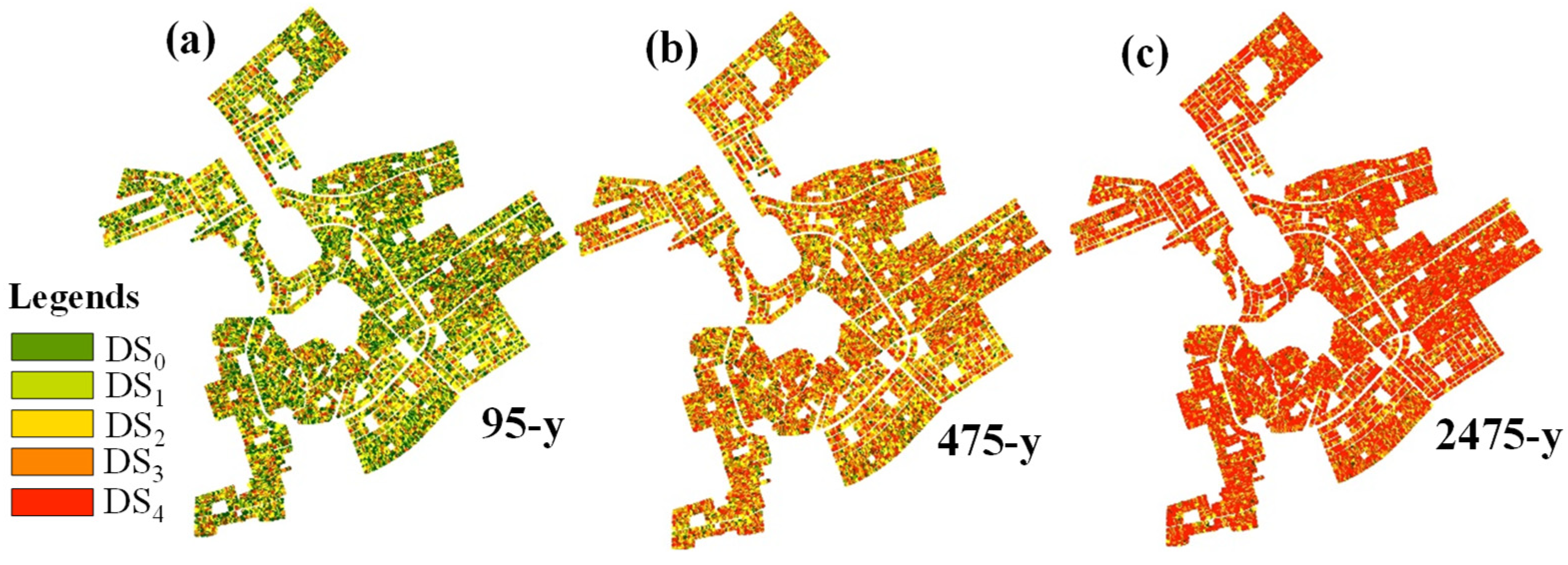

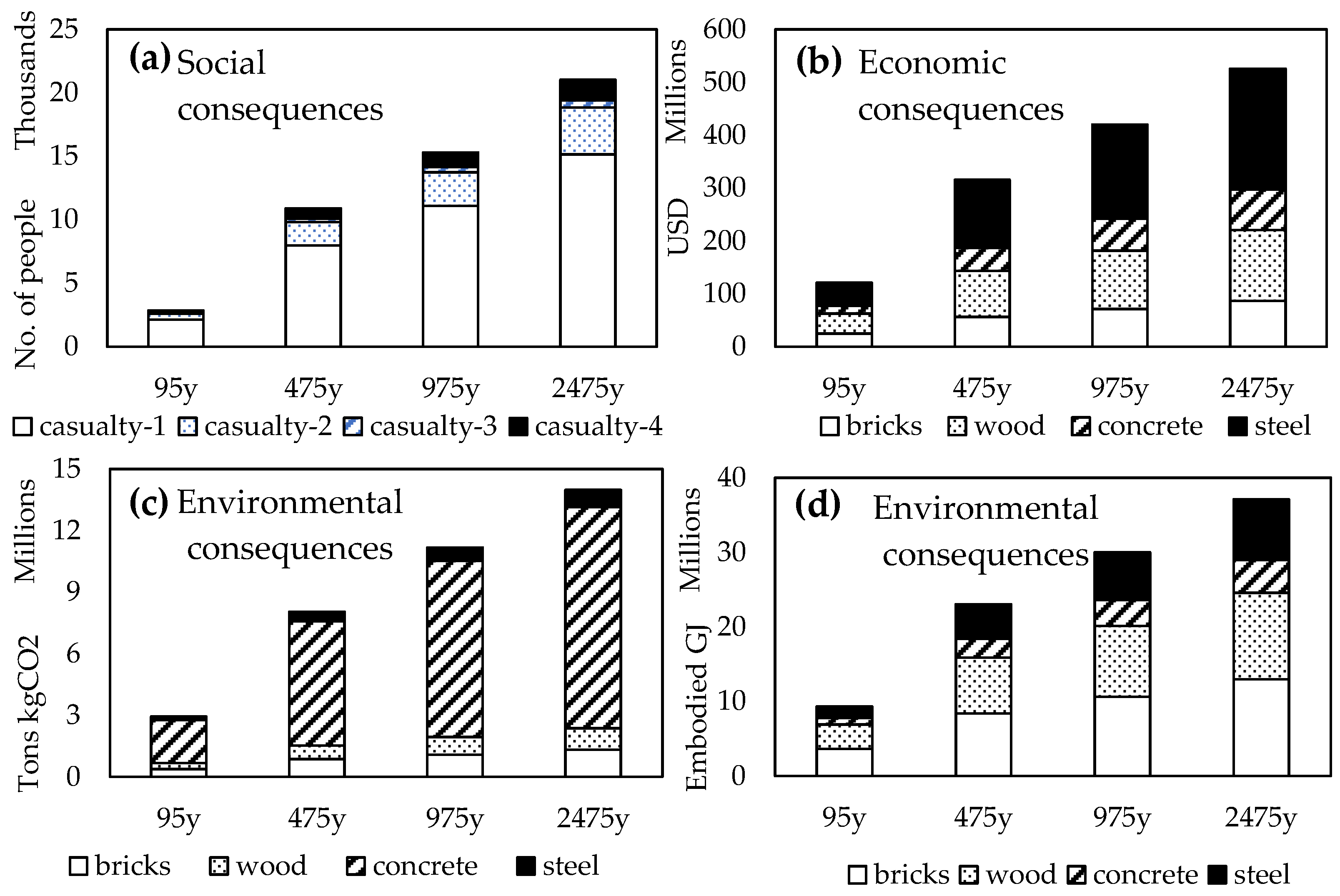
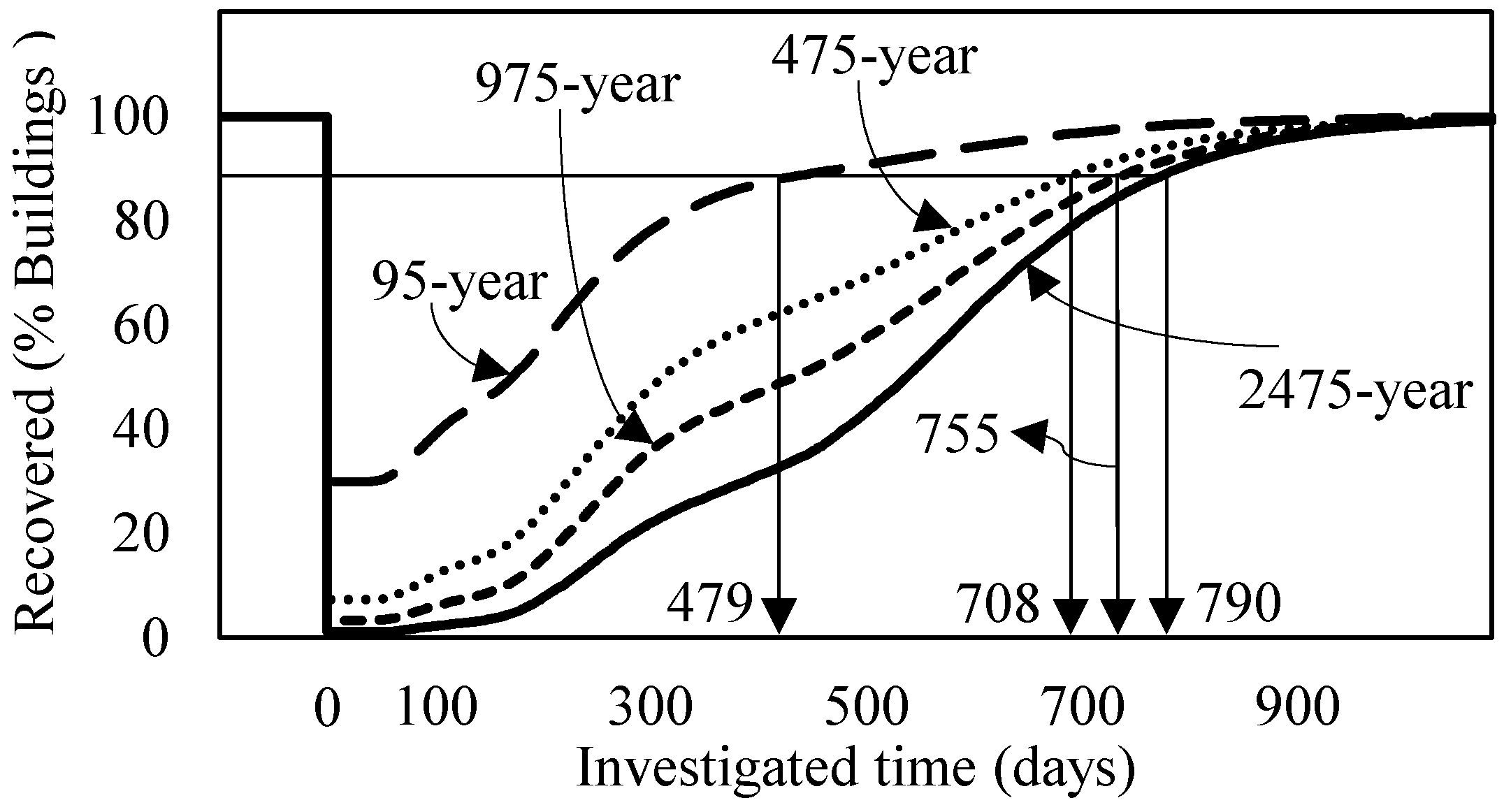
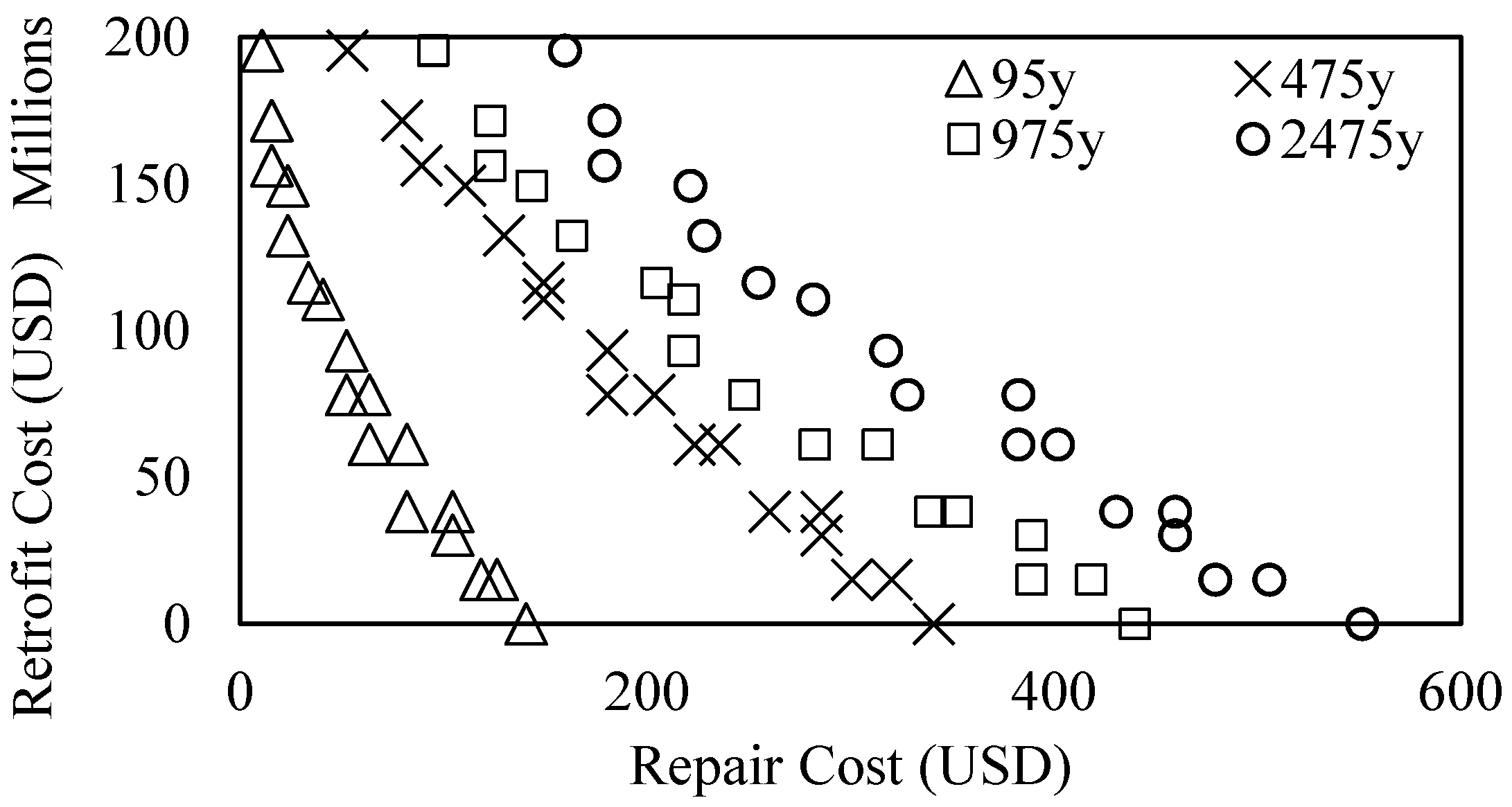


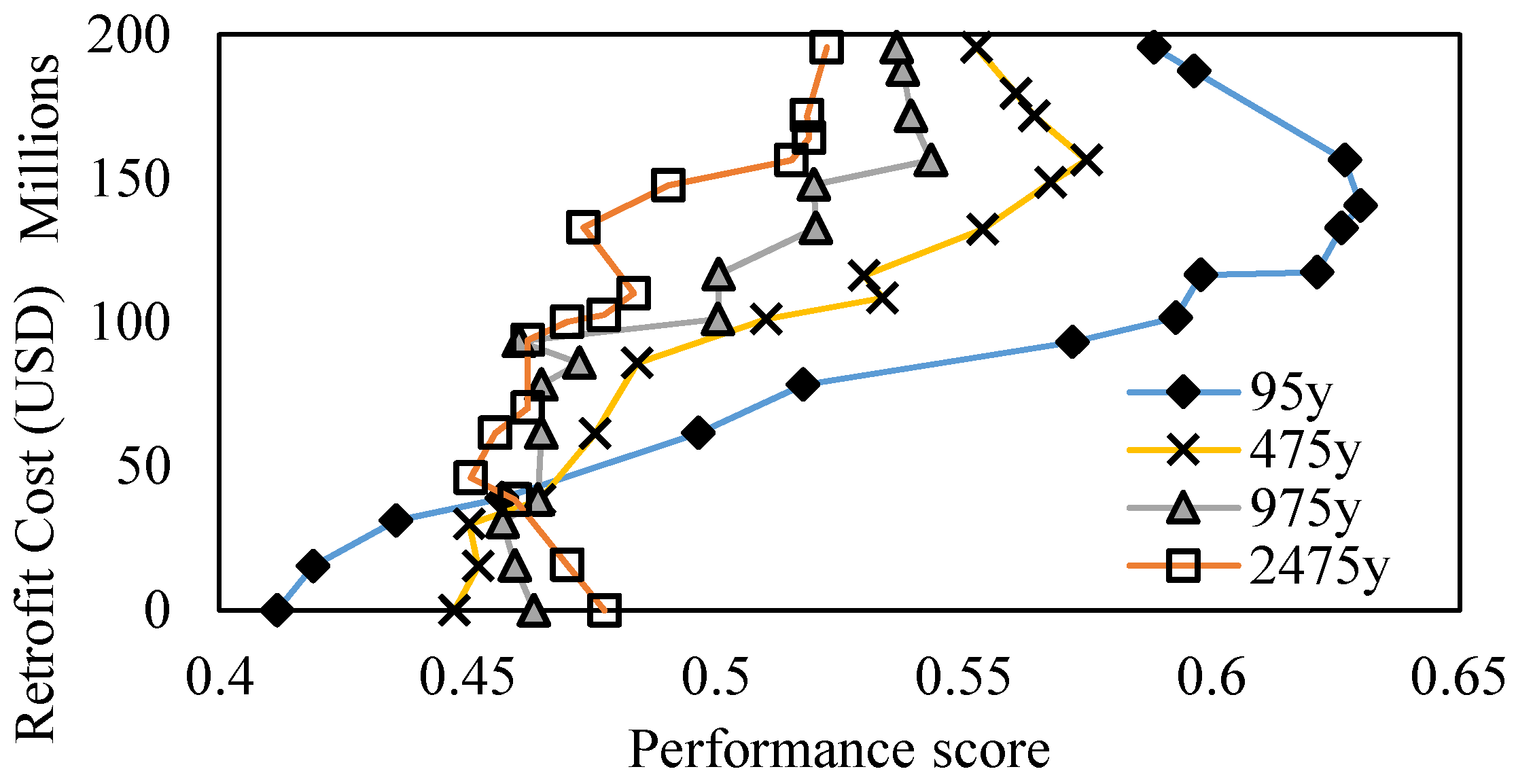
| Performance Objectives | Retrofit Costs (USD) | Total Number of Injuries | Total Repair Costs (USD) | Total Downtime (Days) | Total Carbon Emissions (Tons kg CO2) | Total Embodied Energy (GJ) |
|---|---|---|---|---|---|---|
| Retrofit costs (USD) | 1.00 | 0.50 | 2.00 | 3.00 | 4.00 | 5.00 |
| Total number of Injuries | 2.00 | 1.00 | 2.00 | 3.00 | 4.00 | 5.00 |
| Total repair costs (USD) | 0.50 | 0.50 | 1.00 | 2.00 | 3.00 | 4.00 |
| Total downtime (days) | 0.33 | 0.33 | 0.50 | 1.00 | 2.00 | 3.00 |
| Total carbon emissions (Tons kg CO2) | 0.25 | 0.25 | 0.33 | 0.50 | 1.00 | 2.00 |
| Total embodied energy (GJ) | 0.20 | 0.20 | 0.25 | 0.33 | 0.50 | 1.00 |
Disclaimer/Publisher’s Note: The statements, opinions and data contained in all publications are solely those of the individual author(s) and contributor(s) and not of MDPI and/or the editor(s). MDPI and/or the editor(s) disclaim responsibility for any injury to people or property resulting from any ideas, methods, instructions or products referred to in the content. |
© 2023 by the authors. Licensee MDPI, Basel, Switzerland. This article is an open access article distributed under the terms and conditions of the Creative Commons Attribution (CC BY) license (https://creativecommons.org/licenses/by/4.0/).
Share and Cite
Anwar, G.A.; Hussain, M.; Akber, M.Z.; Khan, M.A.; Khan, A.A. Sustainability-Oriented Optimization and Decision Making of Community Buildings under Seismic Hazard. Sustainability 2023, 15, 4385. https://doi.org/10.3390/su15054385
Anwar GA, Hussain M, Akber MZ, Khan MA, Khan AA. Sustainability-Oriented Optimization and Decision Making of Community Buildings under Seismic Hazard. Sustainability. 2023; 15(5):4385. https://doi.org/10.3390/su15054385
Chicago/Turabian StyleAnwar, Ghazanfar Ali, Mudasir Hussain, Muhammad Zeshan Akber, Mustesin Ali Khan, and Aatif Ali Khan. 2023. "Sustainability-Oriented Optimization and Decision Making of Community Buildings under Seismic Hazard" Sustainability 15, no. 5: 4385. https://doi.org/10.3390/su15054385








